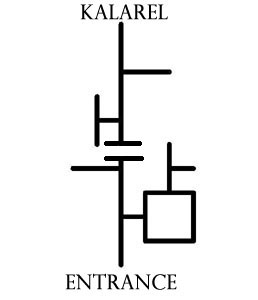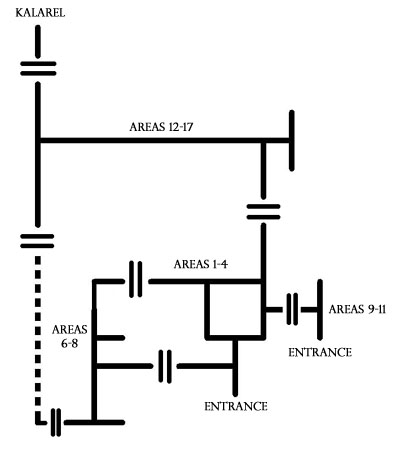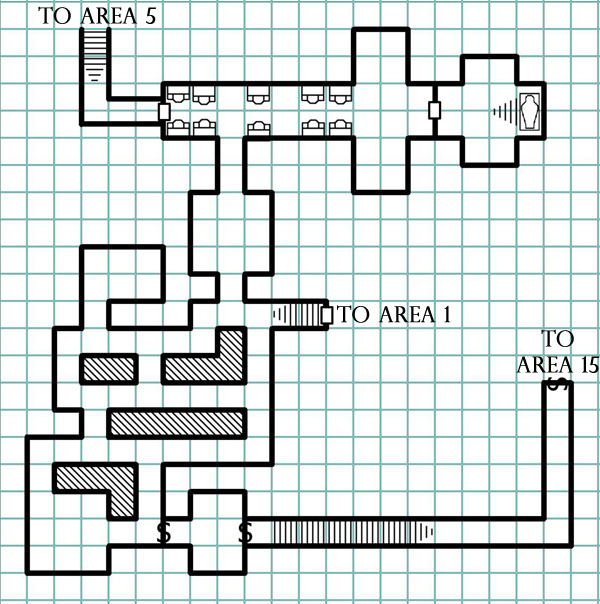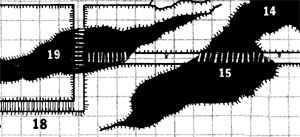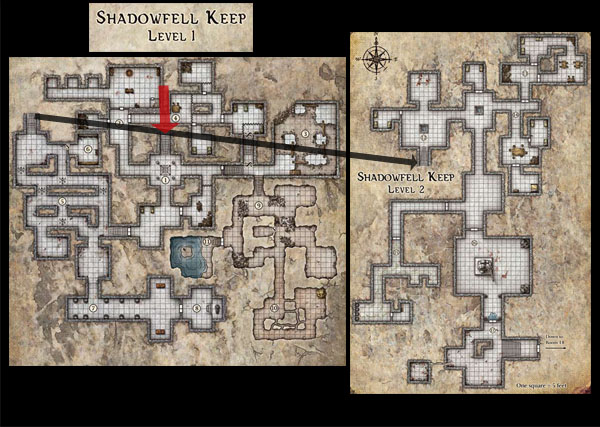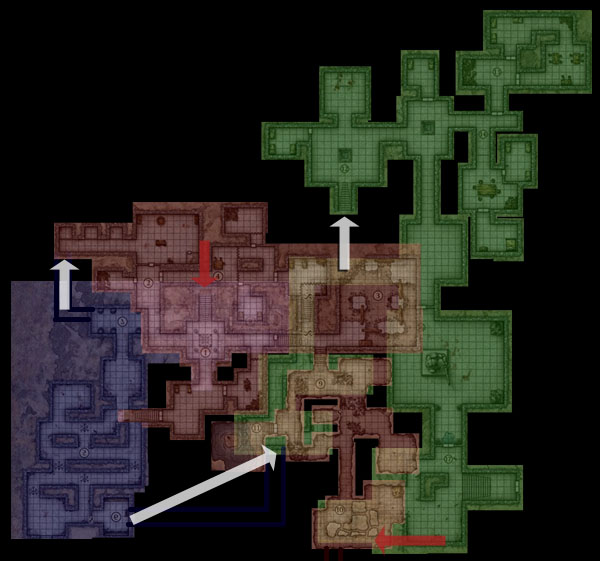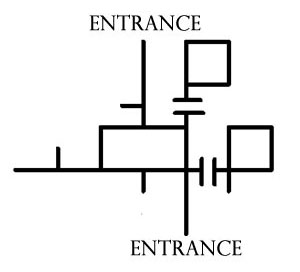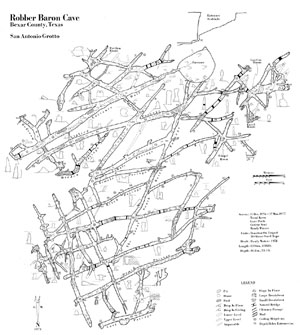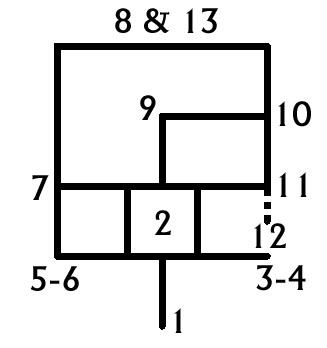This was originally written as part of the main sequence for the “Xandering the Dungeon” essay, but it rapidly grew to a size which proved disruptive to the essay as a whole. Nevertheless, I think it remains a useful resource and so I present it here as a separate addendum.
Many of the Xandering Techniques deal with elaborating, enumerating, or complicating the transitions between levels. So let’s take a moment to consider the many different ways in which levels can be connected to each other.
STAIRS: The very first level connector mentioned in all of D&D. They feature prominently on the “Sample Cross Section of Levels” dungeon map provided on page 3 of Volume 3: The Underworld & Wilderness Adventures in the original 1974 ruleset. (A map which also featured sub-levels, divided levels, multiple entrances, and elevation shifts.)
SLOPES: Similar to stairs, but without the stairs. Sounds simple enough, but in the absence of stairs long, gentle slopes can transition PCs between levels without them realizing that they’ve shifted elevation.
CHUTES: Vertical passages that cannot be traversed on foot. They require either climbing or flight.
LADDERS: Like a chute, but with a climbing aid already onsite. Variants of the ladder include ropes, poles, pre-driven pitons, and antigravity fields.
TRAPDOORS: Trapdoors may lead to stairs, slopes, chutes, or ladders, but they may also taunt PCs from the middle of a ceiling. Or drop down directly into a lower chamber.
WINDOWS: In Dark Tower, Jaquays gives us a window looking down into a lower level of the dungeon (with something looking back up at the PCs). One could also imagine a vertical dungeon in which PCs could fly up to a higher level and find an alternative entrance by smashing through a more traditional window.
TELEPORTS: Teleportation effects allow for rapid transit through larger dungeon complexes, but also have the potential to leave PCs disoriented until they can re-orient themselves at the other end. Teleports can be either one-way or two-way.
TRAPS: Pit traps that drop PCs into an underground river three levels below. One-way teleportation traps that leave them unexpectedly stranded in a far corner of the dungeon (or staring at a familiar entrance). Greased slides that send them shooting down to lower levels. Moving walls that shove them off subterranean cliffs.
Traps that force the PCs to enter a new level are usually designed to be one-way trips. But sometimes resourceful characters will find a way to reverse the journey nonetheless.
MULTI-LEVEL CHAMBERS: Large, vertical chambers can contain entrances leading to different levels within the dungeon. For example, one might imagine subterranean gorges and cliffs. Or an obsidian pyramid squatting in a massive cavern, its steps leading to a burial chamber connecting to an upper level.
ELEVATORS: In their most basic configuration elevators are chutes with a self-propelling means of passage, but taking a page from Star Trek’s turbolifts and Wonka’s Chocolate Factory suggests that elevators don’t always have to be limited to the vertical plane. Others may require the PCs to provide the means of propulsion. (A grinding wheel? Magical fuel? Blood sacrifices? Mystic keys?)
Gygax and Arneson also refer us to “sinking rooms”, reminding us that fantasy elevators don’t need to feel at home in the Empire State Building. And may not exist to serve the interests or comforts of their passengers.
BASKET AND PULLEY: These are similar to elevators in their operation, but have the distinction of allowing their passengers to directly observe their surroundings for the duration of their trip. (The small size of a “basket” might also serve to suggest that entire adventuring parties may not be able to take the journey at the same time.)
ETHEREAL TRAVEL: Sections of the dungeon in which normally solid obstacles (like the floor) can be moved through by way of the Ethereal Plane (or similarly transdimensional/non-Euclidian egress).
RIVERS: A natural variant of the slope. If the river runs flush with the walls, however, getting back upstream may require some tricky swimming. (And if it runs flush with the ceiling, navigating the river may require some deep breaths.)
UNDERWATER: In the real world, the fluid level in any connected system has to be the same, which means that underwater journeys will be most useful in moving PCs across divided levels, nested levels, or to sub-levels on the same horizontal plane of the dungeon.
However, magic, alchemy, and steampunk technology can provide any number of airlocks and semi-permeable barriers allowing for underwater dives to the depths of an otherwise dry dungeon.
Or possibly the PCs will be responsible for flooding those lower levels. (In a minor way if they just swum down a stagnant, submerged shaft. Or in a major way if they dump an entire subterranean lake into the 8th level of the dungeon.)
COLLAPSED PASSAGES: A variant on any chute, stair, shaft, slope, or passage. Or, rather, where there used to be a chute, stair, shaft, slope, or passage. Its former existence may be obvious or it may be obfuscated, but it’s going to require some excavation before the passage will be usable again.
A common variant on this theme is the doorway which has been deliberately bricked up or plastered over. It’s not unusual for such passages to be obvious from one side but not from the other.
TRANSPORT: Think Charon on the River Styx. Harpies willing to carry women (or men disguised as women, their eyesight is very poor) up a shaft. A PC being sucked bodily into a fist-sized ruby which is then carried aloft by a silver raven. The form has an essentially limitless variety, but the basic idea is that the PCs are being transported through the agency of an NPC or monster.
BEING SWALLOWED: “The cave is collapsing.” “This is no cave.” Esophageal jaunts to the lower reaches of the dungeon should probably be used sparingly, but will certainly be memorable when they are employed. (The vomitous method of ascension is less pleasant, but no less memorable.)
BRUTE FORCE: Tunneling through walls using a stone shape spell. Levitating or flying through “unreachable” vertical passages. Using gaseous form to traverse “impassable” air vents. Blind or scry-prepped teleports. Casting ethereal jaunt to phase through solid stone. Basically this is a catch-all for PCs finding paths where no paths were meant to be. This isn’t really something you can plan for (although you might be able to encourage it by giving the PCs maps as part of their treasure), but you should try to keep in mind that they’re not cheating when they do it. (An attitude which may be easier to hold onto if the dungeon already has multiple paths to success designed into its non-linear structure.)
Part 2: Tips and Tricks

